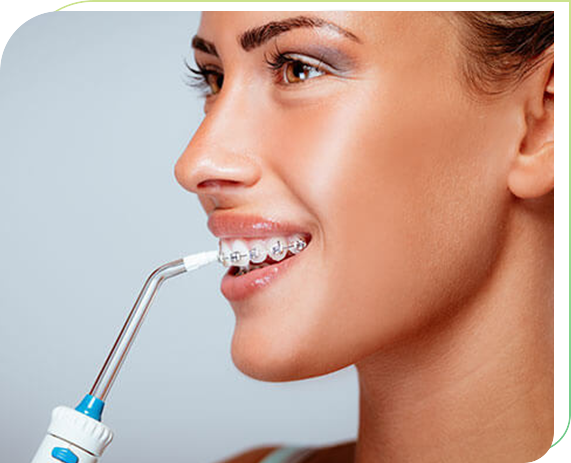Electric Water Flosser – Everything You Need to Know

 Dental Care
Dental Care
What is a Electronic Water Flosser?
If you find it difficult to use traditional dental floss then a water flosser could be a good alternative. Water flossers wash away food debris and plaque from between the teeth and around the gums helping to improve oral health. It’s just like flossing only it’s done with water which is why the procedure is often referred to as a water floss.
A water flosser, or an oral irrigator as it’s often called, is a hand-held device that looks similar to an electric toothbrush. They come in a variety of guises and are known by many names including a waterjet flosser, a teeth water flosser, and a dental water flosser.
How does a water flosser work?
To perform a water floss the device needs to be filled with water and switched on. This causes it to eject streams of water that help clean in between your teeth and around the gumline.
Typically, a water flosser will have a variety of pressure settings. This allows a beginner to use gentler pressure while a more confident user can increase the jet speed if they wish.
During the process a high-powered spray of water will effortlessly blast away food particles, bacteria and plaque leaving your mouth both clean and healthy.

The benefits of a electronic water flosser
There are many benefits when you water floss and it’s a great addition to include in your oral care routine. We’ve outlined some below:
Safely aids dental treatments
Water floss can help with certain dental procedures such as dental implants which require that good oral hygiene is maintained at all times to maximise longevity. Using a dental water flosser is a safe gentle way to clean the teeth without disrupting a post-treatment procedure.
It’s also possible to lower the water pressure and angle the head of a water flosser without the threat of dental floss getting caught around the wires of a dental brace.
Lowers the risk of gum disease
The stream of water emitted from a water flosser has the ability to penetrate below the gum line, thus cleaning out more bacteria than would be possible with string floss. As a result, the risk of gum disease and cavities may be reduced.
Easy to use
Unlike string flossing, water floss requires minimal manual dexterity to achieve great results and the entire mouth can be cleaned in less than a minute.

Types of Water Flossers
When you’re considering a water flosser there are two main types to choose from.
Countertop Water Flosser
This is a large, heavy waterjet flosser that comes with a cord and, as its name suggests sits on a countertop close to a power outlet. They come in a range of sizes and offer a variety of features. Typically, a large countertop flosser will have the biggest water reservoir, offer more pressure settings for customised cleaning power, and have more advanced settings. A compact countertop device, on the other hand, will have a balance of features in a smaller and more convenient size.
Cordless Water Flosser
These differ from countertop devices in that they have a small water reservoir which makes them lightweight, more compact, and more importantly, portable. They operate with batteries although many of them use rechargeable batteries and come equipped with a recharging stand.
Cordless water flossers have been proven to be as effective as countertop flossers with the additional benefit that they can be taken on your travels wherever in the world you happen to be going.
Different Types of Tips for Water Flossers
Just as there are different types of water flossers so there are different tips that perform different functions. Your basic teeth water flosser should come with a few different tips – the most common of which include:
- Classic jet tip – This should come as standard and is intended for daily use. It’s designed for deep cleaning between the teeth as well as beneath the gum line.
- Orthodontic tip – This is perfect for kids or adults wearing braces and has a tapered brush that removes plaque effectively. It’s also good for cleaning out bacteria and food debris lodged around the teeth and beneath the gums.
- Toothbrush tip – This has the design of a manual toothbrush and enables you to brush and floss simultaneously.
- Tongue cleaner – Shaped like a spoon, it traps and removes bacteria from the tongue, keeping your breath fresh.
If you find removing particles of food from your teeth to be an arduous task and one you deeply dislike, then do yourself a favour and invest in a water flosser.
Signs That You May Need a Water Flosser
Flossing is an important part of oral care that helps to keep your teeth and gums healthy. Here are some signs that may indicate the need to consider water flossing rather than traditional dental flossing.
- You find it difficult to use string floss – It’s hard to get the floss between the gaps in your teeth and doing so often causes your gums to bleed. If this is the case, consider water flossing rather than risk leaving food debris stuck between your teeth that can cause tooth decay.
- Your teeth are crooked – When teeth aren’t straight it’s more difficult to move string floss back and forth to remove food debris. A water flosser can do the job more efficiently and in a fraction of the time.
- Orthodontic work makes it harder to use string floss – Orthodontic braces can make it tricky to floss in the traditional way.
You just don’t like string flossing – Flossing with traditional dental floss can seem a chore but with a water flosser, it’s actually quite good fun.
A water flosser is a great tool to help with healthy teeth and gums when used in conjunction with regular brushing and flossing and is the ideal way to help keep your teeth plaque and bacteria-free.
If you are considering investing in a water flosser but aren’t sure if you need one, check out Denfinity. You can find a cool water flosser that can help boost the results of your daily oral healthcare routine.
